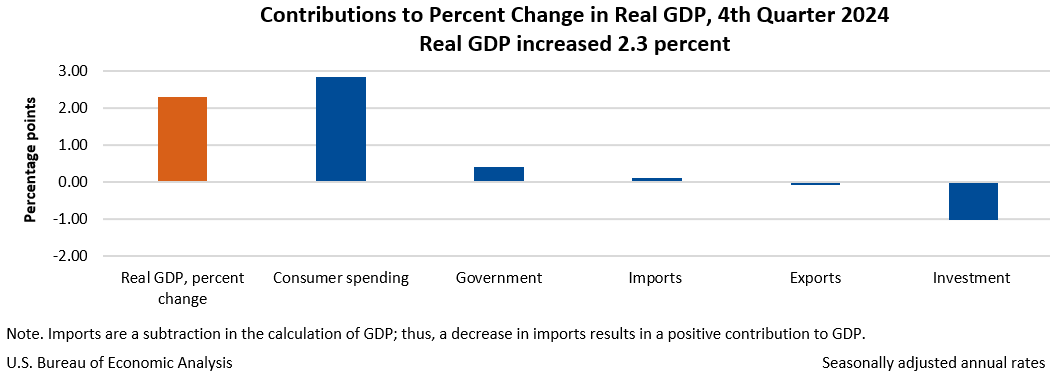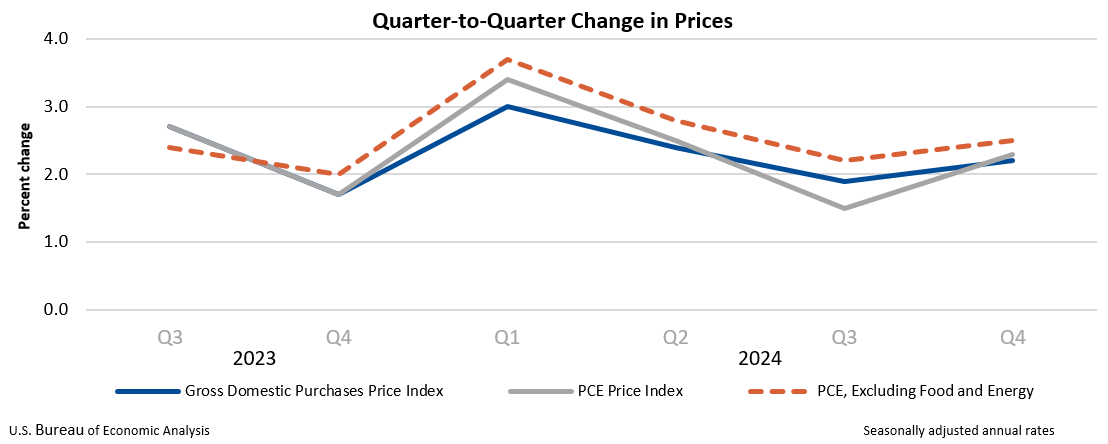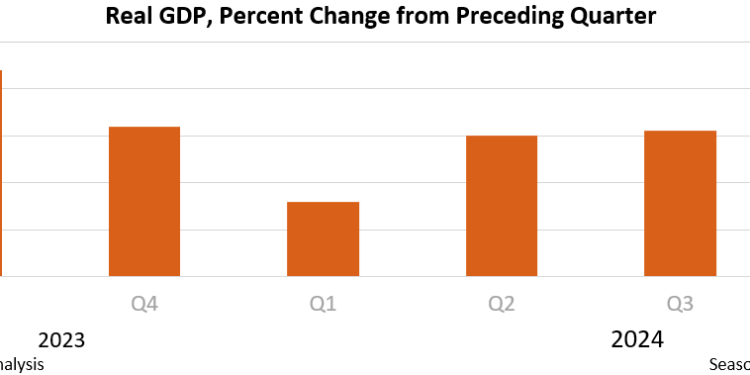Gross domestic product (GDP) Real increased to an annual rate of 2.3% in the fourth quarter of 2024 (October, November and December), according to the prior estimate published by the American Office of Economic Analysis. In the third quarter, real GDP increased by 3.1%.

Increased Real GDP In the fourth quarter, it mainly reflected the increase in consumption and public spending that was partly offset by a decrease in investment. Imports, which are subtraction of GDP calculation, have decreased. For more information, see “technical notes” below.

Compared to the third quarter, the deceleration in Real GDP In the fourth quarter, he mainly reflected slowdowns in investment and exports. Refused imports.
THE Price index for raw interior purchases increased by 2.2% in the fourth quarter, against an increase of 1.9% in the third quarter. THE Personal consumer expenses price index (PCE) Increase of 2.3%, against an increase of 1.5%. By excluding food and energy prices, the PCE price index increased by 2.5%, against an increase of 2.2%.

| Real GDP and related measurements | |
|---|---|
| (Percentage of change compared to the previous quarter) | |
| Real GDP | 2.3 |
| GDP running from the current country | 4.5 |
| Undo price for indoor purchasing | 2.2 |
| PCE index | 2.3 |
| PCE price index excluding food and energy | 2.5 |
GDP for 2024
Real GDP An increase of 2.8% in 2024 (of the annual level of 2023 at the annual level of 2024), against an increase of 2.9% in 2023. The increase in real GDP in 2024 reflected an increase in consumption expenditure, investments, public spending and exports. Imports increased.
THE Price index for raw interior purchases increased by 2.3% in 2024, against an increase of 3.3% in 2023. PCE index Increase of 2.5%, against an increase of 3.8%. By excluding food and energy prices, the PCE price index increased by 2.8%, against an increase of 4.1%.
Next version: February 27, 2025, at 8:30 am HNE
Gross domestic product, 4th quarter and year 2024 (second estimate)
Technical notes
Sources of change for the real GDP
Real GDP increased to an annual rate of 2.3% (0.6% at a quarterly rate1), mainly reflecting the increases in consumer and government spending. Imports, which are subtraction of GDP calculation, have decreased.
- The increase in consumption expenditure has reflected an increase in services and goods. Within services, the main contributor to the increase was health care. Within goods, the main contributors to the increase were leisure products and vehicles as well as motor vehicles and parts.
- As part of health services, hospital services and nursing care (in particular hospital services) and ambulatory services have increased, mainly based on statistics from the Statistics Statistics (BLS) Statistics in terms of employment (These), gains and data on the hours.
- The increase in goods and recreational vehicles was carried out by information processing equipment, based on monthly data on the statement of the census office retail.
- The increase in motor vehicles and parts has been directed by new light trucks, based mainly on the unit sales of Wards Intelligence.
- The increase in public spending reflected an increase in spending by states and the federal government and the federal government.
- As part of government and local expenditure, the increase was led by employee remuneration, mainly based on BLS employment data.
- As part of the federal government’s expenses, the increase was led by defense consumption expenditure, based mainly on monthly data on cash declarations.
More information on the source data and the assumptions of BEA which underlie the estimate of the fourth quarter is presented in the table of the main data and hypotheses.
Impact of Hurricane Milton on estimates of the fourth quarter 2024
Hurricane Milton marked the landing as a category 3 oil just south of Tampa Bay, Florida, October 9, 2024, causing damage caused by strong winds, including a large tornado activity and In -depth interior floods.
This disaster disrupted the usual activities of consumers and businesses and caused emergency services and correction activities. The responses to this disaster are included, but not identified separately, in the source data that Bea uses to prepare GDP estimates; Therefore, it is not possible to estimate the overall impact of the Hurricane Milton on the GDP of the fourth quarter. The destruction of fixed assets, such as residential and non -residential structures, does not directly affect GDP or personal income. Bea estimates of disaster losses are presented in Table 5.1 of the NIPA, “Saving and Investment”. Bea preliminary estimates show that Hurricane Milton has led to losses of 27.0 billion dollars in private assets (108.0 billion dollars at an annual rate) and 3.0 billion dollars in fixed active ingredients State and premises ($ 12.0 billion at an annual rate).
For more information, see “how are production and income measures in national accounts assigned by a disaster?” And “How are the fixed fixed assets (FAAS) and the consumption of fixed capital (CFC) affected by disasters?”
1. percent of changes in the quarterly seasonal adjusted series are displayed at annual rates, unless otherwise indicated. For more information, refer to the FAQ why does Bea publish percentage changes in quarterly series at annual rates?.


